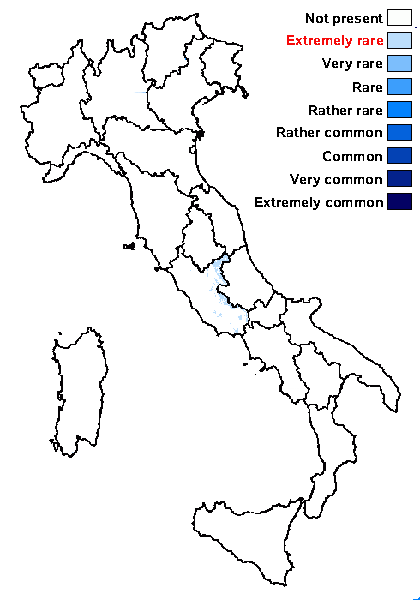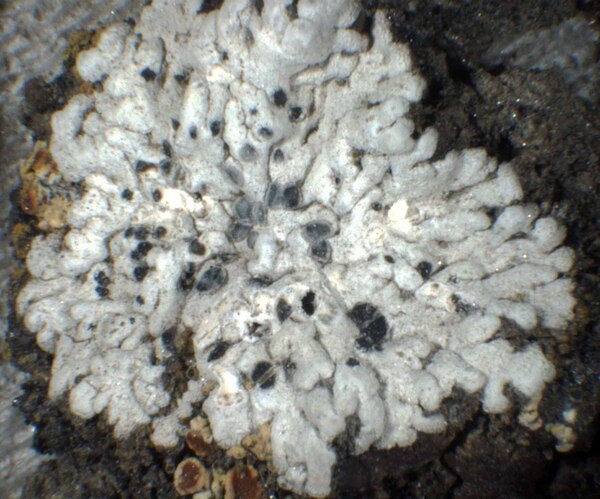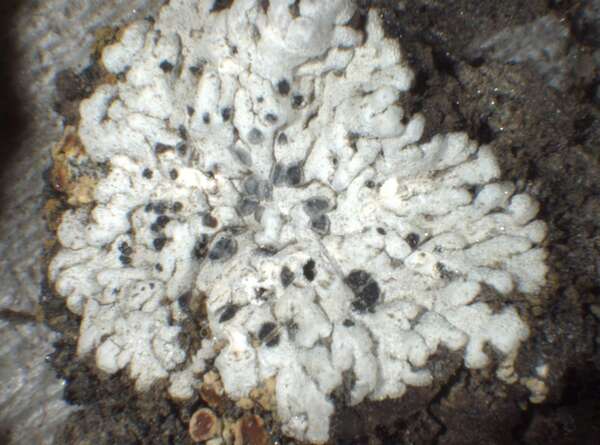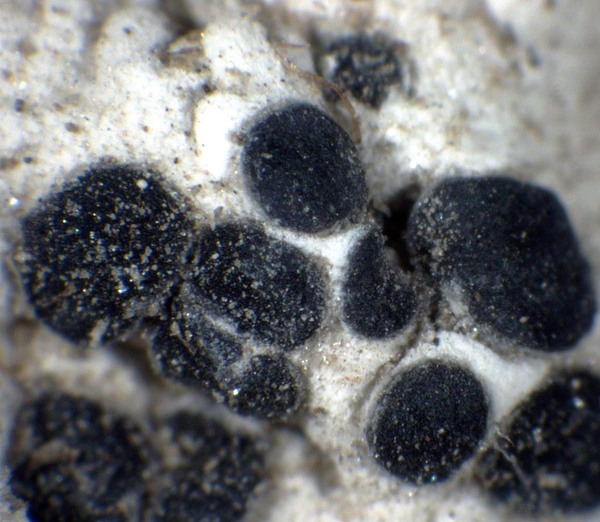Buellia asterella Poelt & Sulzer
Nova Hedwigia, 25: 182, 1974.
Synonyms:
Distribution: C - Laz (Trinkaus & Mayrhofer 2000).
Description: Thallus crustose-placodioid, white, with radiating marginal lobes, forming c. 2 cm wide, orbicular rosettes, the lobes 0.3-0.5 mm broad, 5-8 mm long, elongate, flattened to weakly convex, strongly white-farinose-pruinose. Phenocortex up to 75 µm thick, filled with crystals; medulla white, filled with crystals of oxalates. Apothecia frequent, lecideine, sessile, (0.1-)0.4-0.8(-1.2) mm across, with a black, flat to slightly convex, sometimes pruinose disc, and a thin, smooth, finally excluded proper margin. Proper exciple up to 60 µm wide laterally, of more or less radiating hyphae, pale brown throughout, or paler in inner part; epithecium yellowish brown, 10-15 µm high; hymenium colourless. 50-70(-80) µm high; paraphyses 2.5-3.5 µm thick at mid-level, the apical cells 3.5-5 µm wide, with a dark cap; hypothecium pale to medium brown, up to 100 µm high. Asci 4-spored, clavate to cylindrical-clavate, the apical dome K/I+ dark blue with a pale, conical-pointed apical cushion (axial mass), the wall I-, but the thin outer gel I+ blue, Bacidia-type. Ascospores 1-septate, slightly constricted at septum, pigmented, ellipsoid, (10-)11-16(-19) x (4.5-)5-8(-8.5) µm, Buellia-type, with a microfoveate ornamentation. Pycnidia rare, dark, immersed. Conidia bacilliform, 5-8 x 1-2 µm. Photobiont chlorococcoid. Spot tests: thallus K+ yellow turning red (very rarely K-), C-, KC-, P+ yellow-orange or very rarely P-. Chemistry: atranorin and variable amounts of norstictic acid. Note: a mainly western European species growing on calciferous or gypsaceous soil in dry grasslands. According to Spribille & Wagner (2016), it is presently extinct over much of its former range: the only verifiable extant populations at present are in the Vågå region of Norway, where only two of three historical sites have been confirmed, and even these are in sharp decline.
Growth form: Crustose placodiomorph
Substrata: soil, terricolous mosses, and plant debris
Photobiont: green algae other than Trentepohlia
Reproductive strategy: mainly sexual
Commonnes-rarity: (info)
Alpine belt: absent
Subalpine belt: absent
Oromediterranean belt: absent
Montane belt: extremely rare
Submediterranean belt: extremely rare
Padanian area: absent
Humid submediterranean belt: absent
Humid mediterranean belt: absent
Dry mediterranean belt: absent

Predictive model
Growth form: Crustose placodiomorph
Substrata: soil, terricolous mosses, and plant debris
Photobiont: green algae other than Trentepohlia
Reproductive strategy: mainly sexual
Commonnes-rarity: (info)
Alpine belt: absent
Subalpine belt: absent
Oromediterranean belt: absent
Montane belt: extremely rare
Submediterranean belt: extremely rare
Padanian area: absent
Humid submediterranean belt: absent
Humid mediterranean belt: absent
Dry mediterranean belt: absent

Predictive model
 INDEX FUNGORUM
INDEX FUNGORUM
 GBIF
GBIF





